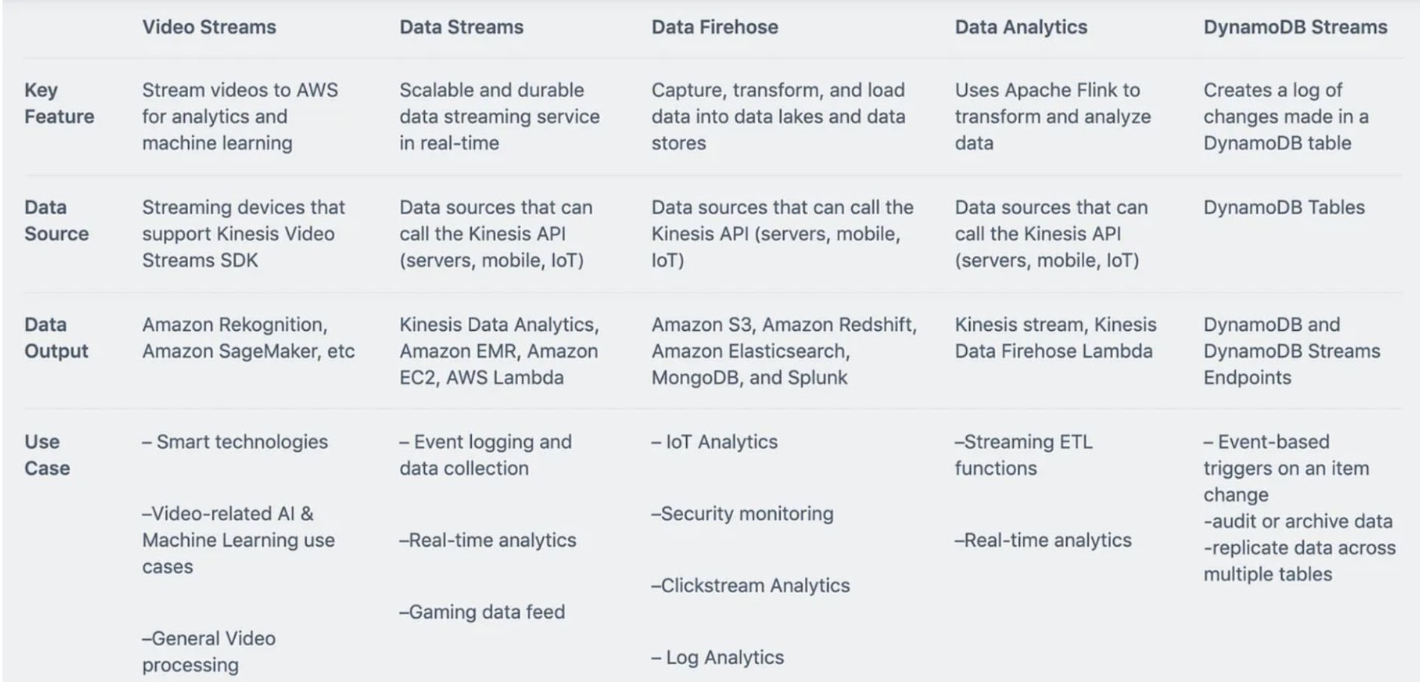What is Amazon Kinesis?
Amazon Kinesis is a suite of services that provide a way to easily collect, process, and analyze real-time data. This helps businesses make better decisions based on new insights from well-processed Kinesis data. It is also extremely cost-effective at any scale. Some use cases of Amazon Kinesis include video/audio solutions, website clickstreams, and IoT data.
Amazon Kinesis Data Firehose is the easiest way to capture, transform, and load streaming data into data lakes, data stores, and analytics services. Firehose, like other Kinesis services, is fully managed and automatically scales to match the throughput of your data and requires no ongoing administration. It can also batch, compress, transform, and encrypt your data streams before loading, minimizing the amount of storage used while at the same time increasing security.
Kinesis Data Analytics
Amazon Kinesis Data Analytics is the easiest way to transform and analyze streaming data in real-time with Apache Flink. Apache Flink is an open-source framework and engine for processing data streams. Amazon Kinesis Data Analytics reduces the complexity of building, managing, and integrating Apache Flink applications with other AWS services.
Real-time applications: Amazon Kinesis enables users to build custom streaming applications for their streaming requirements
It can be used for application monitoring, fraud detection, and live leaderboards
Data ingestion: Amazon Kinesis can be used to capture, store, and process the data from large, distributed streams that can include event logs and social media feeds etc
Real-time analytics: Amazon Kinesis provides the ability to perform real-time analytics on data that has traditionally been analyzed using batch processing.
It can be used for anomaly detection in IoT device readings and real-time digital advertising updates based on data.
Securely stream video: Amazon Kinesis provides securely streamed video from camera-equipped devices in homes, factories, offices, and public places to AWS.
These video streams can be used for video playback, security monitoring, machine learning, and other analytics.
Limitations of Amazon Kinesis for Real-Time Data Processing
Amazon Kinesis is a powerful tool for real-time data processing, but it does have some limitations. Here are some of the limitations of Amazon Kinesis for real-time data processing:
Complexity: Amazon Kinesis can be complex to set up and manage, especially for users who are not familiar with AWS services
Limited retention: Amazon Kinesis has a default retention period of 24 hours, which can be extended up to 7 days.
Limited processing options: Amazon Kinesis provides limited processing options, and users may need to use other AWS services such as AWS Lambda or Kinesis Analytics to process data
Limited data transformation: Amazon Kinesis does not provide built-in data transformation capabilities, which means that users may need to use other AWS services such as AWS Lambda or Kinesis Firehose to transform data.
Limited number of shards: Amazon Kinesis has a limit on the number of shards that can be used.
In summary, Amazon Kinesis can be used for real-time applications, data ingestion, real-time analytics, and securely streaming video. It is widely used and is defined as a fully-managed, cloud-based, scalable service provided by Amazon which allows users to process the real-time streaming of large amounts of data per second from a diverse set of sources. Amazon Kinesis can be complex to set up and manage, has a limited retention period, provides limited processing options and data transformation capabilities, and has a limit on the number of shards that can be used. These limitations should be considered when deciding whether Amazon Kinesis is the right solution for a particular use case.
Alternatives to amazon kinesis for real-time data processing
There are several alternatives to Amazon Kinesis for real-time data processing. Here are some of the most popular ones:
Apache Kafka: A distributed, partitioned, replicated commit log service that provides high-throughput, scalable, and durable real-time data streaming
Google Cloud Dataflow: A managed streaming analytics platform for real-time data insights, fraud detection, and other purposes
Apache Flink: An open-source stream processing framework that provides high-throughput, low-latency, and fault-tolerant data streaming
Azure Stream Analytics: A fully managed real-time data stream processing service provided by Microsoft Azure
Confluent: A real-time data streaming platform based on Apache Kafka that provides enterprise-level features and support
In summary, there are several alternatives to Amazon Kinesis for real-time data processing, including Apache Kafka, Google Cloud Dataflow, Apache Flink, Azure Stream Analytics, and Confluent. These alternatives provide similar functionality and can be used depending on the specific requirements of the use case.
Amazon DynamoDB Streams
Amazon DynamoDB Streams keeps track of changes made in a DynamoDB table and stores this information in a log for up to 24 hours. Applications can access this log and view the data items as they appeared before and after they were modified, in near-real time.
Whenever an application creates, updates, or deletes items in the table, DynamoDB Streams writes a stream record with the primary key attributes of the items that were modified. A stream record contains information about a data modification to a single item in a DynamoDB table. You can configure the stream so that the stream records capture additional information, such as the “before” and “after” images of modified items.
Kinesis vs DynamoDB Streams Summed Up
You have to understand the use cases of these different services in order to perform well on the exam. So, when you see Data Streams, think, scalable and durable data streaming. When you see Data Firehose think of capture, transform, and deliver. When you see Data Analytics, think of real-time analytics with Apache Flink. Video streams is easy because its use cases all deal with video processing and machine learning. DynamoDB Streams is unique from Kinesis in that it creates a log of changes made that can then be used to trigger other services. I hope that clears it up for you, if not — below is the visual table for reference.
Comparison Table

The key benefit of Amazon Kinesis is that it enables you to process and analyze data as it arrives instead of having to wait until all your data is collected before the processing can begin. It is a real-time, fully managed, and scalable service that meets your in-time processing needs.
There are four types of Kinesis services that we’ll be going over in this article: Video Streams, Data Streams, Data Firehose, and Data Analytics.
Kinesis Video Streams
Amazon Kinesis Video Streams (as its name indicates) makes it easy to securely upload videos in real-time to AWS for analytics, machine learning, playback, and video processing. Kinesis Video Streams automatically provisions/scales all the infrastructure needed to ingest streaming video data from millions of devices so you don’t have to worry about the configuration of the environment.
Video Streams stores and encrypts data gathered from your streams. One popular use case of Kinesis Video Streams is livestreaming that most of us see daily on social platforms. Other typical uses include video chatting and peer-to-peer media streaming.
Kinesis Data Streams
Amazon Kinesis Data Streams (KDS) is a scalable and durable real-time data streaming service. It has the ability to capture gigabytes of data per second from hundreds of thousands of sources such as database event streams, financial transactions, social media feeds, IT logs, and location-tracking events. The data collected is available in milliseconds that can then be used for real-time analytics use cases such as real-time dashboards, real-time anomaly detection, dynamic pricing, and more.
Kinesis Data Firehose
Amazon Kinesis Data Firehose is the easiest way to capture, transform, and load streaming data into data lakes, data stores, and analytics services. Firehose, like other Kinesis services, is fully managed and automatically scales to match the throughput of your data and requires no ongoing administration. It can also batch, compress, transform, and encrypt your data streams before loading, minimizing the amount of storage used while at the same time increasing security.
Kinesis Data Analytics
Amazon Kinesis Data Analytics is the easiest way to transform and analyze streaming data in real-time with Apache Flink. Apache Flink is an open-source framework and engine for processing data streams. Amazon Kinesis Data Analytics reduces the complexity of building, managing, and integrating Apache Flink applications with other AWS services.
Amazon DynamoDB Streams
Amazon DynamoDB Streams keeps track of changes made in a DynamoDB table and stores this information in a log for up to 24 hours. Applications can access this log and view the data items as they appeared before and after they were modified, in near-real time.
Whenever an application creates, updates, or deletes items in the table, DynamoDB Streams writes a stream record with the primary key attributes of the items that were modified. A stream record contains information about a data modification to a single item in a DynamoDB table. You can configure the stream so that the stream records capture additional information, such as the “before” and “after” images of modified items.
Advantages:
- Each stream record appears only one time, with no duplicates
- Each stream record appears in the same order of modifications made to a table item
- It comes with auto-scaling functionality to scale shards
- The read requests are free when processing DynamoDB Stream events with Lambda
In summary, DynamoDB Streams is best suited for capturing granular level changes made to DynamoDB tables and processing stream records using AWS Lambda, while Kinesis Streams is better for producing and consuming large volumes of data and using Kinesis Analytics, Kinesis Firehose, and Lambda to process stream records. The choice between the two services ultimately depends on the specific requirements of the use case.
Benefits of using dynamodb streams over kinesis streams.
No additional cost: DynamoDB Streams does not cost anything to enable, whereas Kinesis Streams requires provisioning and payment on a per-shard and per-request basis
No need to manage shards: DynamoDB Streams automatically manages shards, whereas Kinesis Streams requires users to manage the number of shards in their stream.
Direct integration with AWS Lambda: DynamoDB Streams has a direct integration with AWS Lambda, which makes it easy to process stream records using Lambda function.
Granular changes: DynamoDB Streams captures granular level changes made to DynamoDB tables, whereas Kinesis Streams allows for producing and consuming large volumes of data.
Limitations of using dynamodb streams over kinesis streams.
Limited data transformation: DynamoDB Streams does not provide built-in data transformation capabilities, which means that users may need to use other AWS services such as AWS Lambda or Kinesis Firehose to transform data
Limited processing options: DynamoDB Streams provides limited processing options, and users may need to use other AWS services such as AWS Lambda or Kinesis Analytics to process data
Limited data retention: DynamoDB Streams has a default retention period of 24 hours, which can be extended up to 7 days, but this can be a limitation for some use cases
Limited number of shards: DynamoDB Streams has a limit on the number of shards that can be used, which can be a limitation for some use cases
Limited integration options: DynamoDB Streams only integrates with AWS Lambda, whereas Kinesis Streams integrates with Kinesis Analytics, Kinesis Firehose, and Lambda
Disadvantages and Limitations:
Only two processes can simultaneously read from the same stream shared. DynamoDB Streams Lambda handlers have the possibility of infinite recursion. In summary, DynamoDB Streams is a useful feature for tracking granular changes to DynamoDB table items. It provides several advantages, such as no duplicates, ordered modifications, and auto-scaling functionality. However, it also has some limitations, such as the possibility of infinite recursion and only two processes being able to read from the same stream shard.






Add comment